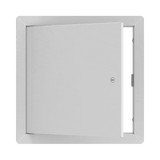Access Doors 101: What You Need to Know for Your Commercial Project
Access doors are essential in commercial buildings, providing easy access to hidden areas for maintenance, repairs, or inspections. Whether you're building or designing a new office space, a retail store, or an industrial facility, understanding the different types of access doors and their applications is important.
This blog post will explore their various uses, key features, benefits, and considerations for your commercial project.
The Role of Access Doors in Commercial Projects
Access doors serve multiple functions in commercial buildings. Understanding their roles can help you address common design, construction, and building management challenges.
Here are the three key areas where they make a significant impact:
Accessibility
Reaching hidden systems for maintenance can be challenging in commercial buildings. Access doors solve this by facilitating easy entry to concealed areas. They allow technicians to inspect and repair equipment and utilities without tearing down walls. This improved accessibility enhances safety and efficiency by enabling quick responses to emergencies and routine maintenance, minimizing downtime and potential hazards.
Code Compliance
Meeting building regulations is a constant challenge in commercial projects. Access doors help ensure compliance with building codes and safety standards. Many jurisdictions require specific access points for fire safety, electrical systems, and other utilities. Proper implementation of access doors helps avoid potential legal issues and maintains a safe environment for occupants.
Aesthetics
While functionality is paramount, aesthetics should not be overlooked in commercial projects. Access doors can be designed to blend seamlessly with the building's overall design and architecture. The ADC-BAC-UAP Flush Universal Access Door with Exposed Flange is a great example. This model features a flush design and an exposed flange, providing a clean, sleek finish that integrates well with various architectural styles. You can also paint and texture this access door to seamlessly blend with its surroundings.
Access Doors Canada is one of the country’s leading suppliers of access solutions. We carry several types of access doors fit for different project types. Check out our website for more products from some of the industry’s top manufacturers like Best Access Doors, Acudor, Cendrex, Karp, and many more.
Types of Access Doors
Commercial projects require various access doors to meet different needs and regulations. Here are some options you may find in the market:
1. General-Purpose Access Doors
General-purpose access doors are the most common type, offering basic access to hidden areas for maintenance and inspections. They are available in various sizes and materials, such as steel, aluminum, and fibreglass.
2. Fire-Rated Access Doors
Depending on their fire rating, fire-rated access doors provide a barrier that slows the spread of fire and smoke for a certain period. This containment helps protect other parts of a building. It also gives more time for occupants to evacuate safely and for emergency services to respond and potentially save lives.
3. Flush Access Doors
A flush access door is designed to sit level with the surrounding wall or ceiling surface. It also comes with concealed hinges and latches, creating a smooth, seamless appearance. This door is often used in areas where aesthetics are a priority, such as high-end commercial buildings.
4. Specialty Access Doors
Aside from the standard types, there are also specialty access doors that offer unique or custom solutions for specific applications. Examples of specialty access doors include:
- Anti-Ligature Access Doors: These doors are designed to prevent self-harm by eliminating ligature points.
- Lead-Lined Access Doors: They are used in areas where radiation shielding is required, such as medical facilities or research laboratories.
- Valve Cabinets: These enclosed cabinets house valves and other plumbing components, providing easy access for maintenance and repairs.
Materials Used in Access Doors
The choice of material for access doors is a critical consideration, as it affects durability, corrosion resistance, and overall performance. Here are some of the most used materials:
- Steel: Steel is a popular choice for access doors due to its strength, durability, and cost-effectiveness. It is available in various grades and can be treated with coatings or finishes to enhance its corrosion resistance.
- Aluminum: Aluminum is a lightweight and corrosion-resistant material often used for access doors in outdoor applications or areas with high humidity.
- Stainless Steel: Stainless steel is a high-quality material known for its exceptional durability and corrosion resistance.
- Plastic: Plastic access doors are a cost-effective and lightweight option suitable for certain applications. They are available in various types and colours and can be easily customized to meet specific requirements.
Access Doors Canada has an extensive inventory of access solutions made of different materials for all sorts of commercial projects. Look here to see what our customers say about our products.
Applications of Access Doors
Access doors are used in various commercial projects to access critical systems and components. Here are some of the most common applications:
- HVAC Systems: Access doors are essential for accessing and maintaining HVAC equipment, such as air handlers, ductwork, and filters.
- Plumbing Systems: Access doors provide access to pipes, valves, and other plumbing components, enabling easy maintenance and repairs.
- Electrical Systems: Access doors are used to access electrical panels, junction boxes, and wiring, ensuring safe and efficient maintenance of electrical systems.
- Security and Surveillance Equipment: Access doors are used to access security cameras, alarm systems, and other security components, facilitating easy installation, maintenance, and troubleshooting.
- Specialized Applications: Access doors are also used in specialized applications, such as cleanrooms, data centers, and laboratories, where controlled access and specific environmental conditions are required.
The specific application will determine the type of access door needed and the required materials, size, and features.
Conclusion
Access doors serve various functions and provide easy access to hidden areas in commercial buildings. Understanding their different types, materials, and applications can help you make informed decisions to ensure your building's safety, functionality, and compliance.
Proper selection and installation of access doors are crucial to avoid potential issues and ensure long-term performance. Access Doors Canada can give you expert advice and assistance in choosing the right product for your commercial project. Contact our team today at (800) 679-3405 or visit our website to request a quote.









